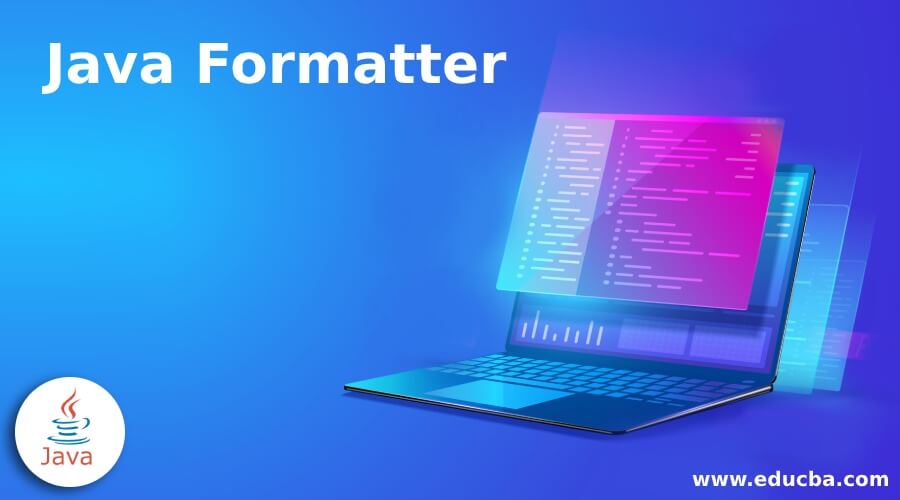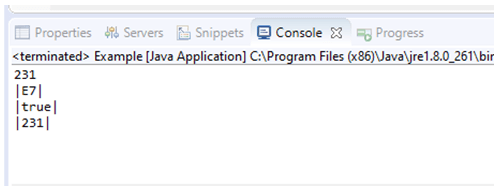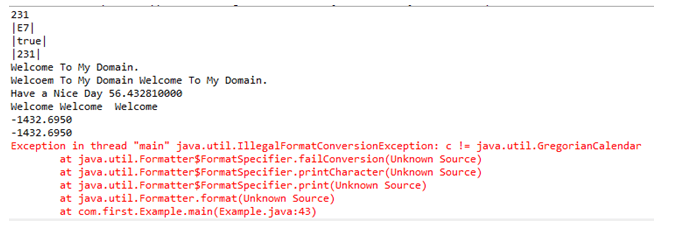Updated May 31, 2023

Introduction to Java Formatter
The Java Formatter is a class in the java.util package that can be used to format and write data to various output formats. It is a final class, meaning it cannot be extended. However, it can implement certain interfaces such as “Closeable” and “Flushable”. By implementing the Closeable interface, the Formatter class provides a default method called close() to release any resources associated with input and output operations.
Syntax:
Java has default packages and its own methods for predefined and customized methods so that it will apply to the user requirements in the project. Likewise, java.util.formatter has some syntax that has been used for declaring the default methods in the projects. Find the below code syntax.
import java.util.*; // it will import all the util components if suppose we need formatter classes only //means we will import that alone
public class{
public static void main(String[] args)
{
Formatter f=new Formatter();//create the instance for the formatter class
f.format(“%1$,.6f”);//example for the format() method arguments we can use any number of arguments based upon the requirements
---some java code logics-----
}
}How does Formatter Function Work in Java?
Java has a constructor for creating the objects. Whenever we have not assigned any constructor in the code, it will automatically call the default constructor. Likewise, we have other java util and io packages classes used for file creation, Accessing the file, read/write buffer storage and data for the file, and other stream functionalities like input, output stream, and PrintStream objects. The Formatter() is one of the main constructors for creating the formatter objects and is one of the no-argument constructors in the java util packages.
If the user specifies the values, it depends upon the project requirements. The argument will be varied upon the constructors if we can use the Formatter(Appendable a, Locale l); the same constructor name has two more arguments, Appendable and Locale locale is one of the region level objects due to this object instance the output data format will be the region-wise according to the user-specified locales. If suppose the user does not mention the locale region it will take and uses the default locale, it’s mainly necessary to tailor the outputs according to the Geo-political or geographical regions based on the cultural sensitives data, such as formatting the date and times the locale object, values will be the decimal point of values that will be separator with the constructor.
Examples of Java Formatter
Following are the examples given below:
Example #1
Code:
package com.first;
public class Example {
public static void main(String[] args) {
String s = String.format("%S", 231);
String s1 = String.format("|%X|", 231);
String s2 = String.format("|%b|", 231);
String s3 = String.format("|%d|", 231);
String s4 = String.format("|%-5d|", 231);
String s5 = String.format("|%5d|", 231);
String s6 = String.format("|%c|", 231);
String s7 = String.format("|%b|", 231);
System.out.println(s);
System.out.println(s1);
System.out.println(s2);
System.out.println(s3);
}
}Output:
Example #2
Code:
package com.first;
import java.util.*;
public class Example {
public static void main(String[] args) {
String s = String.format("%S", 231);
String s1 = String.format("|%X|", 231);
String s2 = String.format("|%b|", 231);
String s3 = String.format("|%d|", 231);
String s4 = String.format("|%-5d|", 231);
String s5 = String.format("|%5d|", 231);
String s6 = String.format("|%c|", 231);
String s7 = String.format("|%b|", 231);
String st1 = "Welcome To My Domain.";
System.out.println(s);
System.out.println(s1);
System.out.println(s2);
System.out.println(s3);
String st2 = String.format("Welcome To My Domain %s", st1);
String st3 = String.format("Have a Nice Day %.9f", 56.43281);
String st4 = String.format("Good Day user %19.7f", 56.43281);
System.out.println(st1);
System.out.println(st2);
System.out.println(st3);
Formatter f=new Formatter();
f.format("%2$5s %4$5s %2$8s", "User",
"Welcome", "To My Domain");
System.out.println(f);
}
}Output:
Example #3
Code:
package com.first;
import java.util.*;
import java.util.GregorianCalendar;
public class Example {
public static void main(String[] args) {
String s = String.format("%S", 231);
String s1 = String.format("|%X|", 231);
String s2 = String.format("|%b|", 231);
String s3 = String.format("|%d|", 231);
String s4 = String.format("|%-5d|", 231);
String s5 = String.format("|%5d|", 231);
String s6 = String.format("|%c|", 231);
String s7 = String.format("|%b|", 231);
String st1 = "Welcome To My Domain.";
System.out.println(s);
System.out.println(s1);
System.out.println(s2);
System.out.println(s3);
String st2 = String.format("Welcome To My Domain %s", st1);
String st3 = String.format("Have a Nice Day %.9f", 56.43281);
String st4 = String.format("Good Day user %19.7f", 56.43281);
System.out.println(st1);
System.out.println(st2);
System.out.println(st3);
Formatter f=new Formatter();
f.format("%2$5s %2$5s %2$8s", "User",
"Welcome", "To My Domain");
System.out.println(f);
StringBuilder sb=new StringBuilder();
Formatter f1=new Formatter(sb);
f1.format(Locale.JAPAN,"%.4f", -1432.695);
System.out.println(f1);
Formatter f2=new Formatter();
f2.format(Locale.US, "%.4f", -1432.695);
System.out.println(f2);
Formatter f3=new Formatter();
f3.format(Locale.GERMANY,"%1$te %1$cB, %2$tY",
Calendar.getInstance());
System.out.println(f3);
Formatter f4=new Formatter();
f4.format(Locale.CANADA,"%3$te %2$tB, %1$cY",
Calendar.getInstance());
System.out.println(f4);
}
}Output:
Conclusion
The java formatter utility classes will be used for different regional continents users will access the applications if it depends upon the web-based applications. When we use a formatter is generally not thread-safe so that the single user will be accessed; moreover not applicable for multi-threading concepts.
Recommended Articles
This is a guide to Java Formatter. Here we also discuss the introduction and how formatter function work in java. along with different examples and code implementation. You may also have a look at the following articles to learn more –




